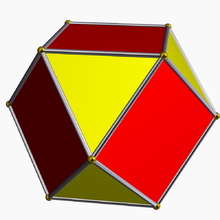


In Euclidean geometry, rectification, also known as critical truncation or complete-truncation, is the process of truncating a polytope by marking the midpoints of all its edges, and cutting off its vertices at those points.[1] The resulting polytope will be bounded by vertex figure facets and the rectified facets of the original polytope.
A rectification operator is sometimes denoted by the letter r with a Schläfli symbol. For example, r{4,3} is the rectified cube, also called a cuboctahedron, and also represented as . And a rectified cuboctahedron rr{4,3} is a rhombicuboctahedron, and also represented as .
Conway polyhedron notation uses a for ambo as this operator. In graph theory this operation creates a medial graph.
The rectification of any regular self-dual polyhedron or tiling will result in another regular polyhedron or tiling with a tiling order of 4, for example the tetrahedron {3,3} becoming an octahedron {3,4}. As a special case, a square tiling {4,4} will turn into another square tiling {4,4} under a rectification operation.

